当前位置:网站首页>Detailed explanation of dynamic planning
Detailed explanation of dynamic planning
2022-07-06 08:47:00 【Anonymous objects of anonymous classes】
Catalog
- Preface
- One 、 Dynamic programming solution
- Two 、 Templates
- 3、 ... and 、 practice
- 931. The descent path is the smallest and ( secondary )
- 1289. The descent path is the smallest and II( difficult )
- The finger of the sword Offer II 099. Sum of minimum paths ( secondary )
- The finger of the sword Offer II 100. The sum of the smallest paths in a triangle ( secondary )
- The finger of the sword Offer II 098. Number of paths ( secondary )
- 72. Edit distance ( difficult )
- 300. The longest increasing subsequence
- 53. Maximum subarray and ( Simple )
- 1800. The largest ascending subarray and ( Simple )
- Throwing eggs in high buildings
- 651. Four key keyboard ( secondary )
- Stone game
- summary
Preface
The steps of algorithm implementation
1、 Create a one-dimensional array or two-dimensional array , Save the results of each sub problem , Whether to create a one-dimensional array or a two-dimensional array depends on the subject , Basically, if the title gives a one-dimensional array to operate , You can just create a one-dimensional array , If the title gives two one-dimensional arrays to operate or two different types of variable values , For example, the volume and total volume of different objects in knapsack problem , Different denominations of change and the total amount of money in the change problem , In this way, you need to create a two-dimensional array .
notes : Creating a two-dimensional array requires a two-dimensional solution , You can create a one-dimensional array and use the rolling array to solve , That is, the values in a one bit array keep changing , I will describe it in detail later
2、 Set array boundary value , One dimensional array is to set the first number , A two-dimensional array is to set the values of the first row and the first column , In particular, scrolling a one-dimensional array is to set the value of the whole array , Then according to the following different data, it will be added and changed into different values .
3、 Find the state transition equation , In other words, find the relationship between each state and its previous state , Write the code according to the state transformation equation .
4、 Returns the desired value , It is usually the last of the array or the bottom right corner of the two-dimensional array .
One 、 Dynamic programming solution
The core design idea of dynamic programming is mathematical induction .
⾸ First , The dynamic programming problem is ⼀ The general form is to seek the maximum value . Dynamic programming is actually an operation research ⼀ It's an optimization ⽅ Law , Just ask on the computer Answer on the question ⽤⽐ More , ⽐ Let's ask for the best ⻓ Increasing ⼦ Sequence , most ⼩ Edit distance and so on .
secondly , The kernel of dynamic programming ⼼ The problem is exhaustion . Because the requirements are the most valuable , Be sure to put all available ⾏ The answer to this question is exhaustive , Then find the best value .
however , The exhaustion of dynamic programming is a little special , Because there are problems like this 「 overlap ⼦ problem 」 , If it's violent ⼒ Exhaustively, the efficiency will be extremely low , So we need to 「 Memorandum 」 perhaps 「DP table」 To optimize the exhaustion process , Avoid unnecessary calculations .⽽ And , Dynamic programming problem ⼀ There will be 「 The optimal ⼦ structure 」, Can pass ⼦ The best value of the problem is the best value of the original problem .
in addition , Although the core of dynamic programming ⼼ Thought is to seek the best value , But the problem can change in a thousand ways , All available resources are listed ⾏ The solution is not ⼀ Pieces of Easy things , Only list the right ones 「 State shift ⽅ cheng 」 , In order to correctly exhaust . As mentioned above overlap ⼦ problem 、 The optimal ⼦ structure 、 State shift ⽅ Process is the three elements of dynamic programming . What do you mean? I'll give you an example , But in practical algorithmic problems , Write state transitions ⽅ Cheng is the most difficult , This is why many friends find dynamic planning difficult Why ,
Two 、 Templates
no
3、 ... and 、 practice
931. The descent path is the smallest and ( secondary )
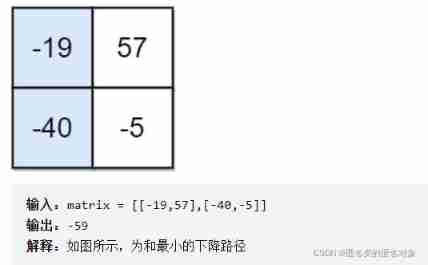
1、 Be clear about status and choice : The status is matrix【i】【j】 The minimum sum of the descent paths of . With the progress of Dynamic Planning ,i from 0 To row,j from 0 To col. Each state has three different choices , Go straight down (i+1,j), lower left (i+1,j-1) And lower right (i+1,j+1).
2、 Determine according to the status dp Array : Determine according to the status ,dp【i】【j】 It is defined as matrix【i】【j】 Is the minimum sum of the descending path at the end .
3、 Determine the state transition equation according to the selection : There are three options for each state ,dp【i】【j】=matrix【i】【j】+min{dp【i-1】【j】,dp【i-1】【j-1】,dp【i-1】【j+1】},i∈【0】【row】,j∈【0】【col】
4、 determine base case: according to dp Array definition and state transition equation , Just make sure dp The upper layer of the array , You can determine each state of the next layer .
class Solution {
public int minFallingPathSum(int[][] matrix) {
int row = matrix.length;
int col = matrix[0].length;
//dp[i][j]: With matrix[i][j] The descending path at the end is the minimum sum
int[][] dp = new int[row][col];
//base case
for (int j = 0; j < col; j++) {
dp[0][j] = matrix[0][j];
}
for (int i = 1; i < row; i++) {
for (int j = 0; j < col; j++) {
int left = 0, right = 0;//left It stands for the upper left ,right It stands for the upper right ,up It means right above
int up = dp[i - 1][j];
if (j - 1 < 0) {
// Because compare the minimum , It is set to int The maximum of
left = Integer.MAX_VALUE;
} else {
left = dp[i - 1][j - 1];
}
if (j + 1 >= col) {
// Same as left
right = Integer.MAX_VALUE;
} else {
right = dp[i - 1][j + 1];
}
// State transition equation
dp[i][j] = matrix[i][j] + Math.min(left, Math.min(right, up));
}
}
int res = Integer.MAX_VALUE;
// Traverse the array to find the minimum
for (int j = 0; j < col; j++) {
res = Math.min(res, dp[row - 1][j]);
}
return res;
}
}
1289. The descent path is the smallest and II( difficult )
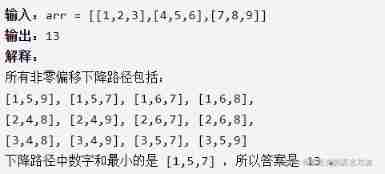
n For the number of lines ,m Represents the number of columns .
1、 States and transitions : The state refers to the minimum sum of the descent paths of each different subscript ; The transfer points to the next line transfer ( Except for the same column ).
2、dp Array : According to the State ,dp[i][j] Referring to matrix[i][j] The descending path at the end is the minimum sum .
3、 State transition equation : According to the transfer ,dp【i】【j】=min{dp【i-1】【k】}, among ,k∈【0,m】&k!=j.
4、base case: According to the state and transition , got it dp The first row of the array can calculate the remaining elements .
class Solution {
public int minFallingPathSum(int[][] matrix) {
int n = matrix.length;
int m = matrix[0].length;
//dp[i][j]: With matrix[i][j] The descending path at the end is the minimum sum
int[][] dp = new int[n][m];
//base case
for (int j = 0; j < m; j++) {
dp[0][j] = matrix[0][j];
}
for (int i = 1; i < n; i++) {
for (int j = 0; j < m; j++) {
dp[i][j] = Integer.MAX_VALUE;
for (int k = 0; k < m; k++) {
int temp;
if (k < 0 || k >= m || j == k) {
// Because compare the minimum , It is set to int The maximum of
temp = Integer.MAX_VALUE;
} else {
temp = dp[i - 1][k];
}
dp[i][j] = Math.min(dp[i][j], temp);
}
dp[i][j] += matrix[i][j];
}
}
int res = Integer.MAX_VALUE;
// Traverse the array to find the minimum
for (int j = 0; j < m; j++) {
res = Math.min(res, dp[n - 1][j]);
}
return res;
}
}
The finger of the sword Offer II 099. Sum of minimum paths ( secondary )
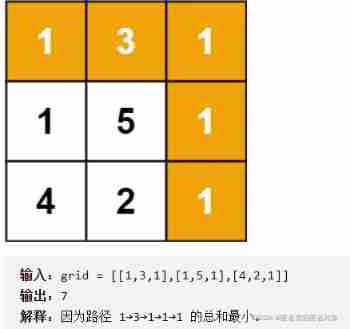
1、 States and transitions : State refers to the minimum path sum of each different subscript . Transition means that there are two choices for each state , Down or left .
2、dp Array : According to the State ,dp[i][j] Referring to grid【i】【j】 The sum of the minimum paths at the end .
3、 State transition equation : According to the transfer ,dp【i】【j】=min{dp【i-1】【j】,dp【i】【j-1】}+grdi【i】【j】.
4、base case: Know the first row and the first column dp, You can launch all dp.
class Solution {
public int minPathSum(int[][] grid) {
int n = grid.length, m = grid[0].length;
int[][] dp = new int[n][m]; //dp[i][j]: With grid【i】【j】 The sum of the minimum paths at the end
//base case
dp[0][0] = grid[0][0];
for (int i = 1; i < n; i++) {
dp[i][0] = dp[i - 1][0] + grid[i][0];
}
for (int j = 1; j < m; j++) {
dp[0][j] = dp[0][j - 1] + grid[0][j];
}
// State shift
for (int i = 1; i < n; i++) {
for (int j = 1; j < m; j++) {
dp[i][j] = grid[i][j] + Math.min(dp[i - 1][j], dp[i][j - 1]);
}
}
return dp[n - 1][m - 1];
}
}
The finger of the sword Offer II 100. The sum of the smallest paths in a triangle ( secondary )

Different from the previous question, the number of columns in this question will change , Each state can be moved down and down right .
class Solution {
public int minimumTotal(List<List<Integer>> triangle) {
int n = triangle.size();
int[][] dp = new int[n][triangle.get(n - 1).size()];
for (int i = 0; i < n; i++) {
Arrays.fill(dp[i], Integer.MAX_VALUE);
}
dp[0][0] = triangle.get(0).get(0);
for (int i = 1; i < n; i++) {
dp[i][0] = dp[i - 1][0] + triangle.get(i).get(0);
}
for (int i = 1; i < n; i++) {
for (int j = 1; j < triangle.get(i).size(); j++) {
dp[i][j] = Math.min(dp[i - 1][j], dp[i - 1][j - 1]) + triangle.get(i).get(j);
}
}
int res = Integer.MAX_VALUE;
for (int j = 0; j < triangle.get(n - 1).size(); j++) {
res = Math.min(res, dp[n - 1][j]);
}
return res;
}
}
The finger of the sword Offer II 098. Number of paths ( secondary )
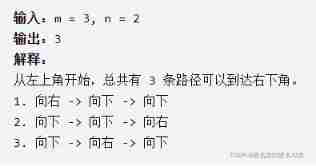
class Solution {
public int uniquePaths(int m, int n) {
int[][] dp = new int[m][n];
Arrays.fill(dp[0], 1);
for (int i = 0; i < m; i++) {
dp[i][0] = 1;
}
for (int i = 1; i < m; i++) {
for (int j = 1; j < n; j++) {
dp[i][j] = dp[i - 1][j] + dp[i][j - 1] ;
}
}
return dp[m - 1][n - 1];
}
}
72. Edit distance ( difficult )
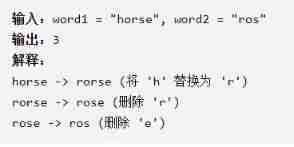
1、 Status and selection : State means word1 and word2 The minimum editing distance of , As the comparison length changes , This state will change with it , Each state has 4 A choice : unchanged , Delete , Replace and add .
For the sake of calculation , Double pointer traversal from back to front .
Insertion time :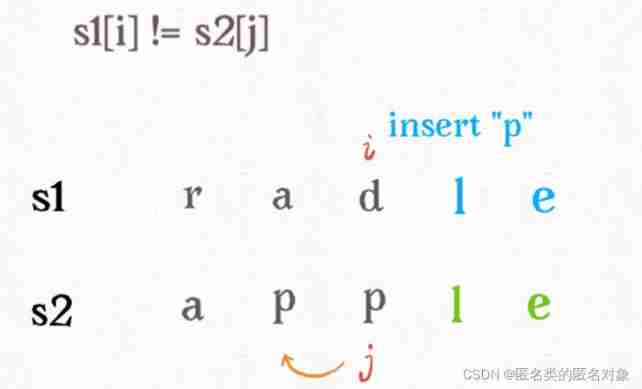
deleted :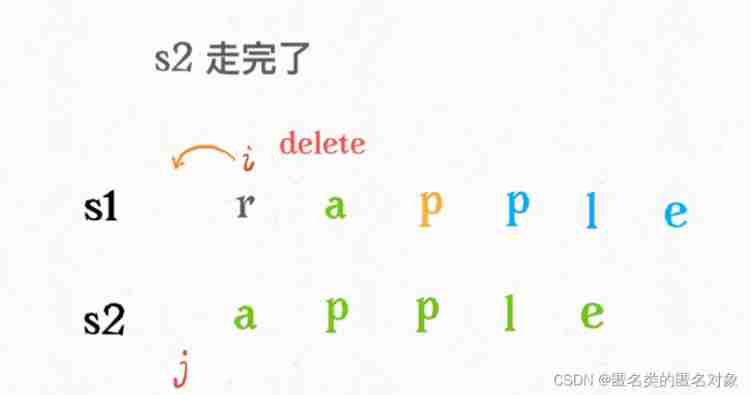
When replacing :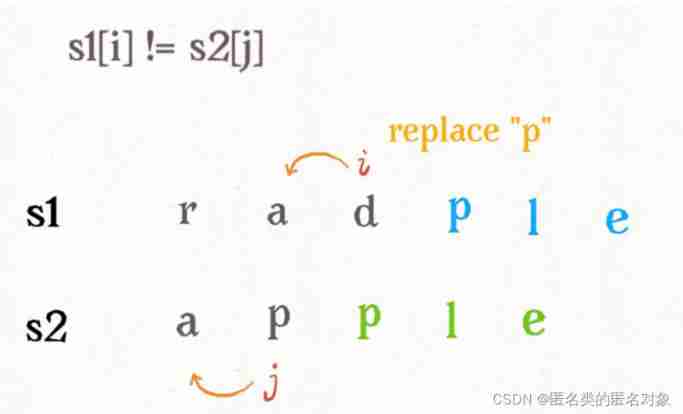
2、dp Array : According to the State ,dp【i】【j】 On behalf of word1【0…i】 and word2【0…j】 The minimum editing distance of .
3、 State transition equation : According to the choice ,dp【i】【j】=min{dp【i-1】【j】,dp【i-1】【j-1】,dp【i】【j-1】}+1 perhaps dp【i-1】【j-1】.
4、base case: Same as above ,dp【i】【j】 And the left , above , The upper left three directions are related . Simultaneous basis dp Definition of array ,dp【i】【0】=i,dp【0】【j】=j;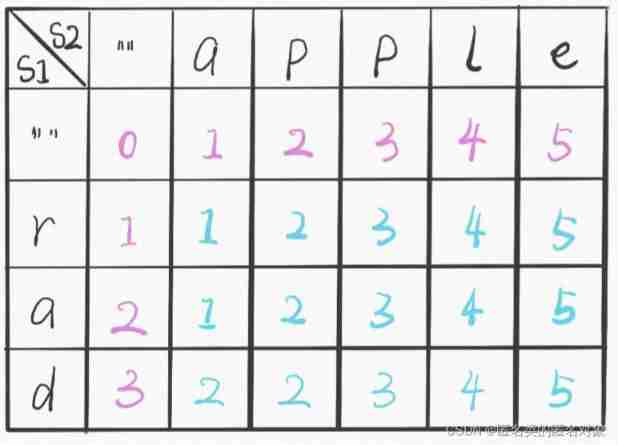
class Solution {
public int minDistance(String word1, String word2) {
int n = word1.length(), m = word2.length();
//dp[i][j]:word1[0...i] and word2[0...j] The minimum editing distance of
int[][] dp = new int[n+1][m+1];
//base case
for (int i = 0; i <= n; i++) {
dp[i][0] = i;
}
for (int j = 0; j <= m; j++) {
dp[0][j] = j;
}
// State transition equation
for (int i = 1; i <= n; i++) {
for (int j = 1; j <= m; j++) {
if (word1.charAt(i - 1) == word2.charAt(j - 1)) {
dp[i][j] = dp[i - 1][j - 1];
} else {
// Delete , Replace , increase
dp[i][j] = 1 + Math.min(dp[i - 1][j], Math.min(dp[i][j - 1], dp[i - 1][j - 1]));
}
}
}
return dp[n][m];
}
}
300. The longest increasing subsequence
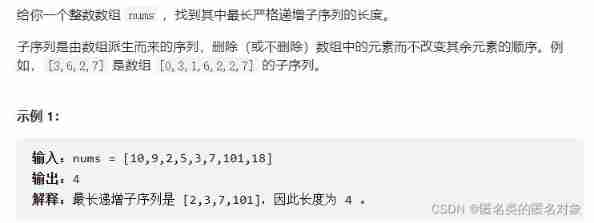
Be careful 「 Subsequence 」 and 「 Substring 」 The difference between these two nouns , The substring must be continuous , And subsequences are not necessarily continuous .
1、 Be clear about status and choice : The status is nums【i】 The longest increasing subsequence of . With the progress of Dynamic Planning ,i from 0 To n. Each state has two different choices for each subsequent number , Choose or not .
2、 Determine according to the status dp Array : Determine according to the status ,dp【i】 It is defined as nums【i】 The length of the longest incrementing subsequence at the end .
3、 Determine the state transition equation according to the selection : There are two options for each state ,dp【i】=max{dp【i】,dp【j】+1},(i∈【0,n】,j∈【0,i)).
4、 determine base case: according to dp Array definition and state transition equation , Just make sure dp【0】 You can determine each of the following dp 了 .
class Solution {
int dp[]; //dp【i】 In order to num【i】 The length of the longest incrementing subsequence at the end
public int lengthOfLIS(int[] nums) {
dp = new int[nums.length];
Arrays.fill(dp, 1);
for (int i = 0; i < nums.length; i++) {
for (int j = 0; j < i; j++) {
if (nums[i] > nums[j]) {
dp[i] = Math.max(dp[i], dp[j] + 1);
}
}
}
int max = Integer.MIN_VALUE;
for (int i = 0; i < dp.length; i++) {
if (dp[i] > max) {
max = dp[i];
}
}
return max;
}
}
53. Maximum subarray and ( Simple )

1、 Status and selection : The state is the largest subarray and , There are two options for each state , Or add the following number , Or the latter number will form a school of its own .
2、dp To define an array : Determine according to the status dp【i】 Stands for nums【i】 Is the largest subarray at the end and .
3、 State transition equation :dp【i】=max{nums【i】,dp【i-1】+nums【i】},i∈【1,n】( among ,nums【i】 It means no choice nums【i】, Its own school , The latter represents choice nums【i】).
4、base case:dp【0】=nums【0】
5、 Optimize : because dp【i】 Only with dp【i-1】 of , So you can be right dp Do state compression , The space complexity will be O(1).
class Solution {
public int maxSubArray(int[] nums) {
int n = nums.length;
//base case
int dp_0 = nums[0];
int dp_1 = 0, res = dp_0;
// State transition equation
for (int i = 1; i < n; i++) {
dp_1 = Math.max(nums[i], dp_0 + nums[i]);
dp_0 = dp_1;
res = Math.max(res, dp_1);
}
return res;
}
}
1800. The largest ascending subarray and ( Simple )
This question is the same as the question , Just dealing with dp【i】 You need to add judgment conditions , If nums【i】>nums【i-1】, Join in nums【i】, otherwise ,nums【i】 A school of its own , restart .
class Solution {
public int maxAscendingSum(int[] nums) {
int n = nums.length;
//base case
int dp_0 = nums[0];
int dp_1 = 0, res = dp_0;
// State transition equation
for (int i = 1; i < n; i++) {
if (nums[i] > nums[i - 1]) {
dp_1 = Math.max(nums[i], dp_0 + nums[i]);
}else{
dp_1=nums[i];
}
dp_0 = dp_1;
res = Math.max(res, dp_1);
}
return res;
}
}
Throwing eggs in high buildings
What's the problem 「 state 」, what are you having? 「 choice 」, Then exhaustive .
**「 state 」** Obviously , Is the current number of eggs K And the number of floors to be tested N. As the test goes on , The number of eggs may be reduced , The search scope of floors will be reduced , This is the change of state .
**「 choice 」** In fact, it is to choose which floor to throw eggs . Review the linear scanning and binary thinking just now , Each time you choose to throw eggs in the middle of the floor section , The linear scan chooses to test up one layer at a time . Different choices will cause the state to shift .
Now it's clear 「 state 」 and 「 choice 」, The basic idea of dynamic planning is formed : It must be two-dimensional dp Array or with two state parameters dp Function to represent the state transition ; Plus one. for Loop through all the choices , Choose the best choice to update the results :
651. Four key keyboard ( secondary )
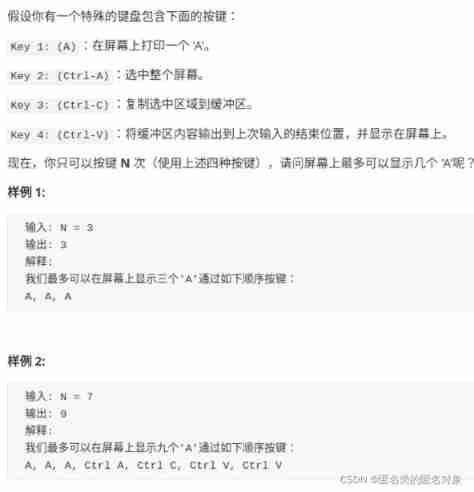
public int maxA(int N) {
int[] dp = new int[N];//dp[i]=value On behalf of i There is value individual a
dp[0] = 0; //base case, Press down 0 Time of a The number is 0;
for (int i = 1; i < N; i++) {
// state 1: whole a
dp[i] = dp[i - 1] + 1;
// state 2: It ends with ctrl+v: Future generations & Copy dp[j-2], Paste continuously i - j Time , Plus what's already on the screen 1 Time
// There are dp[j - 2] * (i - j + 1) individual A
for (int j = 2; j < i; j++) {
dp[i] = Math.max(dp[i], dp[j - 2] * (i - j + 1));
}
}
return dp[N]; // Return to press N The largest after the second a The number of
}
Stone game
What's the problem 「 state 」, what are you having? 「 choice 」, Then exhaustive .
**「 state 」** Obviously , Is the current number of eggs K And the number of floors to be tested N. As the test goes on , The number of eggs may be reduced , The search scope of floors will be reduced , This is the change of state .
from i To j The optimal solution of the selected stone , As the test goes on ,i Increase or remain unchanged ,j Reduce or remain unchanged
**「 choice 」** In fact, it is to choose which floor to throw eggs . Review the linear scanning and binary thinking just now , Each time you choose to throw eggs in the middle of the floor section , The linear scan chooses to test up one layer at a time . Different choices will cause the state to shift .
Choose left or right
Now it's clear 「 state 」 and 「 choice 」, The basic idea of dynamic planning is formed : It must be two-dimensional dp Array or with two state parameters dp Function to represent the state transition ; Plus one. for Loop through all the choices , Choose the best choice to update the results :
class Solution {
public boolean stoneGame(int[] piles) {
int n = piles.length;
Pair[][] dp = new Pair[n][n];
for (int i = 0; i < n; i++) {
for (int j = 0; j < n; j++) {
dp[i][j] = new Pair(0, 0);
}
}
for (int i = 0; i < n; i++) {
dp[i][i].first = piles[i];
dp[i][i].second = 0;
}
for (int l = 2; l <= n; l++) {
for (int i = 0; i <= n - l; i++) {
int j = l + i - 1;
int left = piles[i] + dp[i + 1][j].second;
int right = piles[j] + dp[i][j - 1].second;
if (left > right) {
dp[i][j].first = left;
dp[i][j].second = dp[i + 1][j].first;
} else {
dp[i][j].first = right;
dp[i][j].second = dp[i][j - 1].first;
}
}
}
Pair res = dp[0][n - 1];
return res.first - res.second;
}
}
class Pair {
int first;
int second;
public Pair(int first, int second) {
this.first = first;
this.second = second;
}
}
summary
Tips : Here is a summary of the article :
for example : That's what we're going to talk about today , This article only briefly introduces pandas Use , and pandas Provides a large number of functions and methods that enable us to process data quickly and conveniently .
边栏推荐
- Guangzhou will promote the construction of a child friendly city, and will explore the establishment of a safe area 200 meters around the school
- ROS compilation calls the third-party dynamic library (xxx.so)
- Restful API design specification
- Computer cleaning, deleted system files
- Unified ordering background interface product description Chinese garbled
- Super efficient! The secret of swagger Yapi
- What are the common processes of software stress testing? Professional software test reports issued by companies to share
- View computer devices in LAN
- On the inverse order problem of 01 knapsack problem in one-dimensional state
- TP-LINK enterprise router PPTP configuration
猜你喜欢
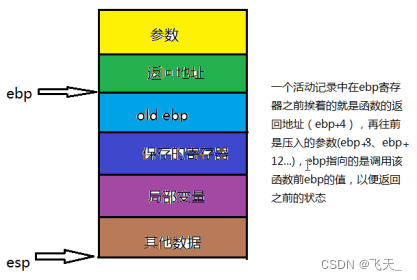
可变长参数
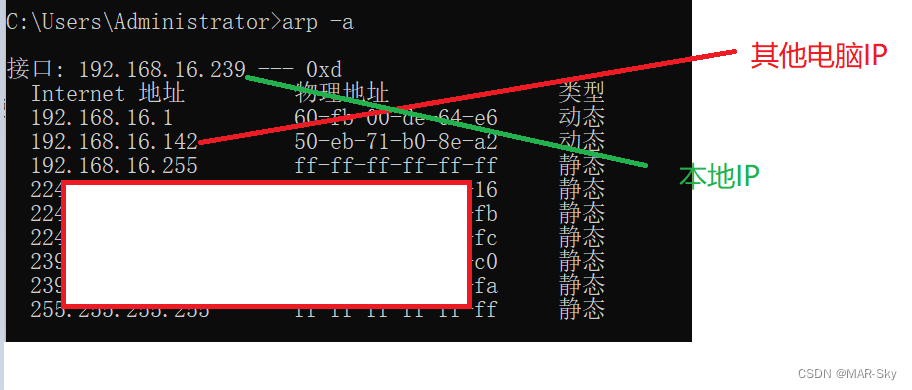
View computer devices in LAN
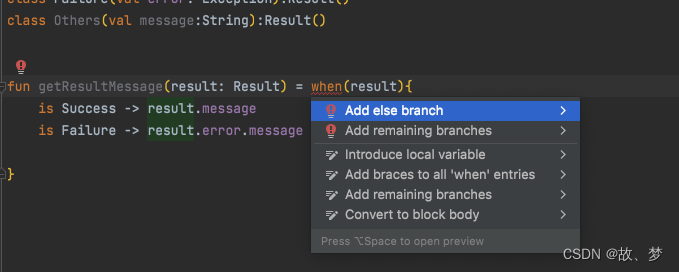
Delay initialization and sealing classes
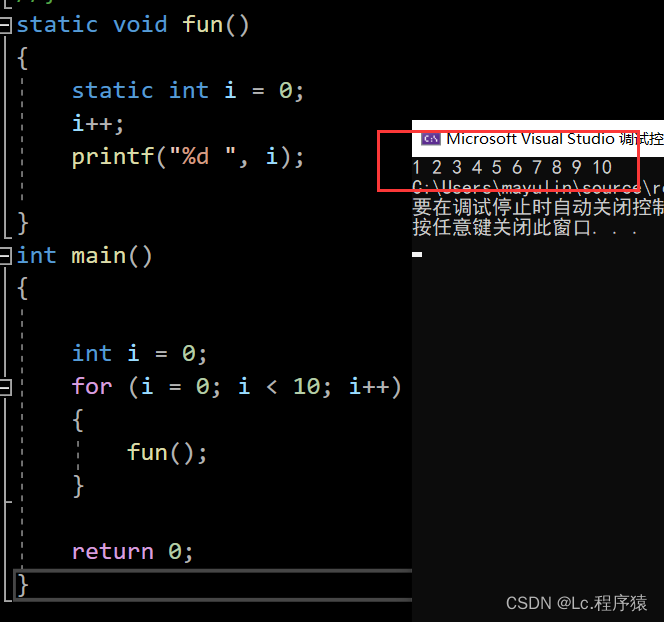
C语言深度解剖——C语言关键字

ROS compilation calls the third-party dynamic library (xxx.so)
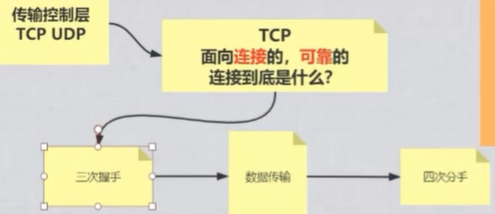
TCP/IP协议

Deep analysis of C language data storage in memory

win10系统中的截图,win+prtSc保存位置
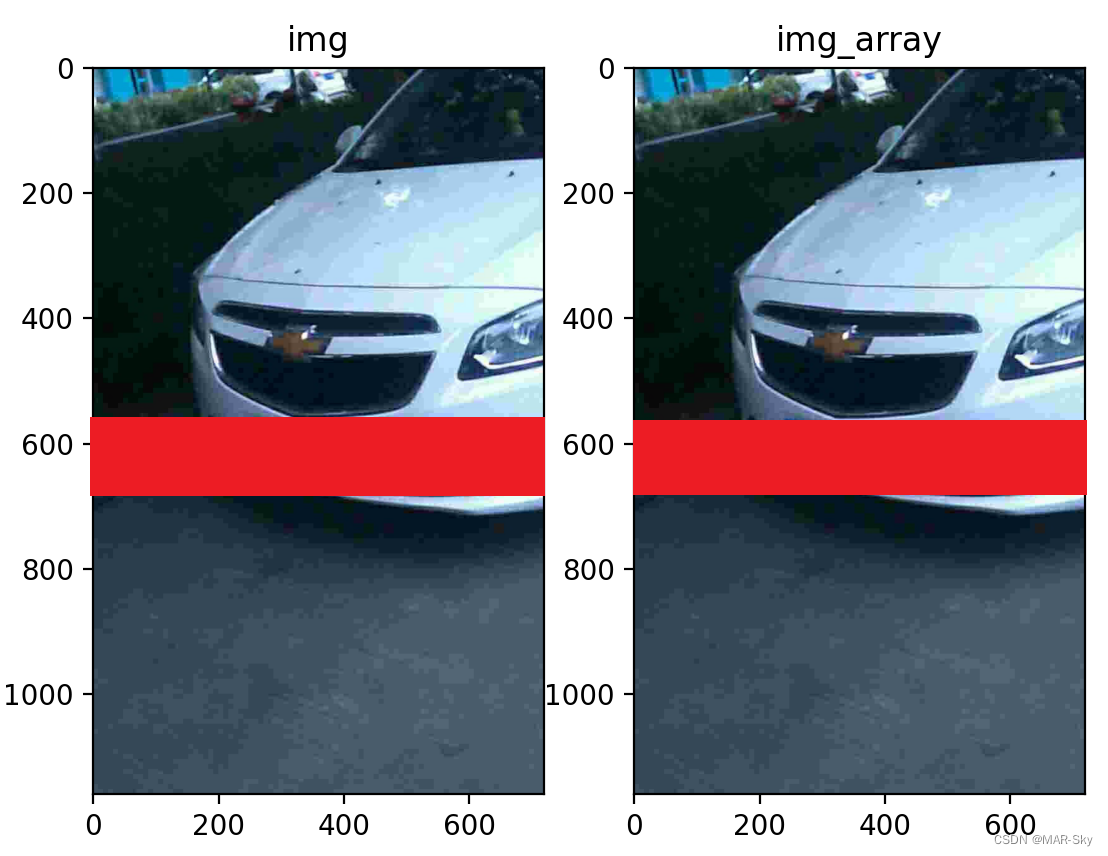
Image,cv2读取图片的numpy数组的转换和尺寸resize变化

Light of domestic games destroyed by cracking
随机推荐
软件压力测试常见流程有哪些?专业出具软件测试报告公司分享
LeetCode:162. 寻找峰值
Light of domestic games destroyed by cracking
Rviz仿真时遇到机器人瞬间回到世界坐标原点的问题及可能原因
Research Report on supply and demand and development prospects of China's high purity aluminum market (2022 Edition)
Navicat premium create MySQL create stored procedure
What is the role of automated testing frameworks? Shanghai professional third-party software testing company Amway
How to effectively conduct automated testing?
win10系统中的截图,win+prtSc保存位置
有效提高软件产品质量,就找第三方软件测评机构
Screenshot in win10 system, win+prtsc save location
What are the common processes of software stress testing? Professional software test reports issued by companies to share
电脑清理,删除的系统文件
The harm of game unpacking and the importance of resource encryption
Tdengine biweekly selection of community issues | phase III
Research Report on Market Research and investment strategy of microcrystalline graphite materials in China (2022 Edition)
Using pkgbuild:: find in R language_ Rtools check whether rtools is available and use sys The which function checks whether make exists, installs it if not, and binds R and rtools with the writelines
查看局域网中电脑设备
@JsonBackReference和@JsonManagedReference(解决对象中存在双向引用导致的无限递归)
JS pure function